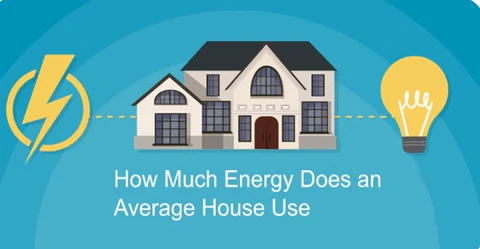How Much Electricity Does My House Use?

Last summer, Michael sat on his porch, sipping coffee and glancing at his electric bill. The number startled him — $280 for a single month. “How could this be?” he muttered. His home hadn’t changed; no new gadgets, no big parties — just regular life. Yet the bill kept climbing. That question, “How Much Electricity Does My House Use?”, led him down a path of discovery that most homeowners eventually walk — understanding where power truly goes and how to control it.
Understanding the Average Home’s Power Use
Electricity consumption varies by home size, location, and habits. The average U.S. household uses about 877 kWh per month, but that number can shift drastically depending on how energy-efficient your appliances are, the number of occupants, and even the weather.
To truly answer “How Much Electricity Does My House Use”, it’s not enough to glance at your bill — you have to dig deeper. Your electricity bill shows total usage, but the story behind those kilowatt-hours (kWh) lies in how your home operates every hour of the day.
Breaking Down Where the Power Goes
Heating and Cooling Systems
Air conditioning and heating systems are often the biggest energy hogs. Depending on your region, they can make up 40–50% of your total electricity use. Poor insulation, leaky ducts, or an aging HVAC unit can silently drive up costs.
Lighting and Appliances
Lighting might seem harmless, but those bulbs add up. Switching from incandescent to LED can reduce lighting costs by up to 75%. Large appliances — like refrigerators, dryers, and ovens — consume major chunks of energy too, especially older models that lack Energy Star certification.
Phantom Power and Standby Loads
Even when turned “off,” many devices — such as TVs, routers, and chargers — continue to draw small amounts of electricity. This phantom load can account for 5–10% of your total energy use without you even realizing it.
How to Measure Your Home’s Energy Use
1. Check Your Utility Bill
Your utility bill lists total kWh used per billing cycle. Compare month-to-month usage to identify spikes, especially during seasonal changes or after adding new appliances.
2. Use a Smart Energy Monitor
Modern energy monitors, like Sense or Emporia, track real-time power usage and identify which appliances consume the most. Installing one on your electrical panel helps you visualize where every watt goes.
3. Try Plug-in Power Meters
For smaller devices, plug-in power meters like the Kill-A-Watt can show exactly how much electricity an individual appliance draws — from your gaming console to your air purifier.
Seasonal Factors Affecting Electricity Usage
Hot Summers
Air conditioning runs more often, ceiling fans stay on, and refrigerators work harder to keep cool. This naturally raises energy consumption.
Cold Winters
Electric heaters, space warmers, and water heaters become the culprits during the cold months. Homes in colder climates often see winter bills rival summer ones.
Transitional Months
Spring and fall tend to be low-usage months — fewer heating and cooling needs, and more reliance on natural light.
Easy Ways to Lower Electricity Consumption
Upgrade to Energy-Efficient Appliances
Investing in Energy Star certified products can reduce electricity use without sacrificing performance.
Improve Home Insulation
Proper insulation in walls, attics, and floors reduces the strain on HVAC systems, keeping temperatures stable and energy bills lower.
Embrace Smart Home Technology
Smart thermostats, motion sensor lights, and energy-tracking apps can help you automate and optimize energy use effortlessly.
Switch to Solar Energy
One of the most effective long-term solutions to managing your power bill is going solar. By producing your own electricity, you not only reduce reliance on the grid but can even generate excess energy to sell back to the utility.
How to Compare Your Usage
When asking “How Much Electricity Does My House Use,” it’s helpful to benchmark yourself against others:
|
Household Type |
Average Monthly Usage (kWh) |
|
Small Apartment |
300–500 kWh |
|
Medium House (2–3 People) |
700–1000 kWh |
|
Large Family Home |
1200–2000 kWh |
If your home consistently exceeds these averages, it’s worth investigating inefficiencies or hidden loads.
The Hidden Costs of Wasted Power
Every unnecessary watt costs money and strains the grid. Beyond financial savings, conserving electricity means reducing your carbon footprint and contributing to a more sustainable environment. What feels like a small change — like unplugging idle devices or switching to LED bulbs — adds up to significant savings over time.
Building a Smarter Energy Future
Understanding your home’s energy use is more than a budgeting tactic — it’s an investment in awareness. Once you know where your electricity goes, you can make smarter choices, cut waste, and even move toward renewable solutions like solar panels or battery storage.
Technology continues to evolve, and the homes of the future will be even more connected, efficient, and self-sustaining. But it starts with a single question — How Much Electricity Does My House Use?
Conclusion
Michael’s story ended with him cutting his electric bill by nearly 40% — all by understanding and managing his consumption. You can do the same. Whether it’s upgrading to efficient appliances, sealing leaks, or installing solar, every action brings you closer to energy independence.
So the next time you open your utility bill, you won’t just see a number — you’ll see opportunity, awareness, and control over your energy future.
- Art
- Causes
- Crafts
- Dance
- Drinks
- Film
- Fitness
- Food
- Jeux
- Gardening
- Health
- Domicile
- Literature
- Music
- Networking
- Autre
- Party
- Religion
- Shopping
- Sports
- Theater
- Wellness



